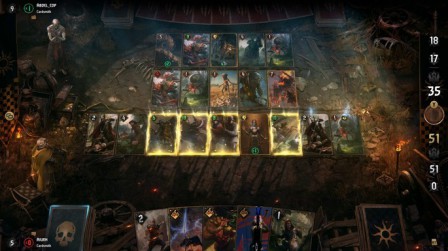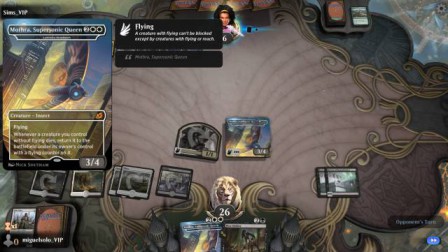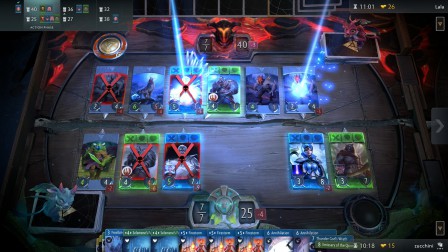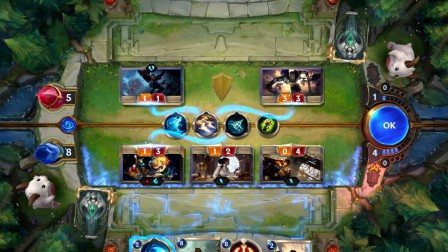Next up in our trip is Faeria, released in 2017. This is another take on the card game with board sub-genre, but this one goes deeper. The board is what they call a "living board", meaning that players build it as the game progresses. You start with an empty board, full of water. Once per turn, each player can create land from water. The cool thing is that those lands, along with allowing you to move your creatures closer to your opponent, are also the resource system! There are five types of lands: a neutral one, the prairie, that is just footing for creatures, as well as the mountain, the desert, the forest and the lake. All of those are what would be levels in Eternal: cards you play require you to have a certain amount of lands.
Faeria also has a cool concept called the Power Wheel. It's the circle with 7 options you can see in the bottom-right corner on the screenshot above. Basically, once per turn, you can activate one of those 7 options: either create a land of one of the four "colored" types, or create two neutral lands, or draw a card, or gain one more mana. This gives a great choice to make every turn, and adds a lot of tactical thinking to the game. Note that the mana system is quite different here than in other CCGs: you have 3 mana to spend every turn, and it doesn't disappear at the end of your turn. So you can choose to not play anything on a specific turn, and accumulate mana to play something bigger on your next turn. There are also sources on the board that give you one mana per turn if you have a creature adjacent to the source.
Of the many games I'm writing about in this series, Faeria is the one that I believe innovated the most. The devs embraced their living board concept and made the most out of it. They also tried something different for their business model. The game was released as a free-to-play, a model that was somewhat standard: you could buy packs of cards and cosmetics, and there was an in-game economy with currencies you would gain by playing. In 2018 they announced that they would move to a pay-to-play model. New players of Faeria have to buy the game once, then they can unlock their collection only by playing. The team also releases paid DLC that give players new content, including new cards and new solo campaigns. From what I've seen, it doesn't seem this model worked too well for the team. According to steamdb, the game has about 75 players connected in average. The reddit community is a tad small (5k subscribers) with little activity. The game was released to PS4 recently though, and is clearly still alive. It's good to see folks trying something different, though I'd love to have more insight into how that turned out for them financially. I'm especially curious about the impact this model had on player acquisition.
Gwent, also released in 2017, is next in the list. Originally a mini-game in The Witcher 3, this CCG is quite different from the rest. A game takes three rounds, players having to play one card each until they both pass. Then the player with the highest power on their side of the board wins the round. Win two rounds to win the game.
The big things about Gwent are that it has no resource system nor fighting between creatures. That's a big change from all the other Magic-inspired games we've seen so far. Gwent could essentially be summarized as a complex trick-taking game. I'm impressed they managed to create nearly 1,000 cards from such simple game mechanics!
I haven't played Gwent a lot as I don't enjoy it much. Its being different from the rest of the field is quite cool. It is on the light side of complexity, close to Hearthstone, maybe even simpler. I'm guessing that, for the same reasons, it brought new players from The Witcher into the CCG genre. One nice thing to note about this game: the developers made a tutorial so big that it's actually a stand-alone game of its own!
The big, big event that happened in 2017, though, was the arrival of a decent digital version of Magic: The Gathering. Arena, also known as MTGA, is really just Magic brought into the digital space by folks who where able to look at what Hearthstone and other previous video games did. The economy, this time, is not tied to the physical cards. MTGA didn't do anything quite new or innovative, but it was a real pleasure for me to finally be able to play Magic, online, in a decently usable software, and without having to spend a ton of money in the game. Don't get me wrong, Arena is still expensive compared to other digital CCGs out there. But when your only alternative was MTGO? Wow.
Arena's take on the excess cards problem was the only "innovation" around. Instead of giving you dust, any excess card you get after your 4th goes to fill a progress bar. When that bar reaches 100%, the game gives you a bunch of wild cards. A wild card is an item that can be transformed into a card of a given rarity: at any time, you can transform one of your rare wild cards into any rare card available in the game. You sometimes also get wild cards by opening booster packs. Other than that, Arena is pretty much just Magic, with its qualities and its weaknesses.
To find some more innovation in the genre, let's take a look at another game designed by Magic's father: Artifact. This game was set in the world of Dota 2, one of Valve's successful IPs. Mostly famous those days for the failure it has been, Artifact has a lot to teach. One of the premises of the design behind the game was that the digital platform allowed to vastly increase the complexity of your typical card game. So it wouldn't have one board, but three. It would have a simple resource system (the same as Hearthstone, except starting at 3 mana), but it would also have another resource, gold, that players could use to buy extra items between turns.
My play experience with Artifact was quite short, as my first game took close to an hour, and that basically was it. And given the charts of player attendance, it seems I was not the only one. Artifact had a number of problems, from its economy to its complexity. There are whole articles about those problems out there — Why Artifact Failed (gamasutra), How Artifact became Valve's biggest failure (eurogamer) — so I'll go over those issues quickly.
The economy on release was a mess, with several different ways of acquiring cards, and all of them costing actual money. That was on top of a paid game. Wait, so you buy a game, and then you have to buy individual cards as well? That was very scary to a lot of players. Valve's goal was to make an actual trading card game, where your collection builds up by trading, selling or buying to and from other players. The last games who did that were MTGO and Scrolls, and as we saw, that didn't work out very well for them.
Artifact had a lot of randomness. And when I say a lot, I mean a LOT. It was not just on cards, it was also on the board: minions attack in a random direction, heroes are dispatched in a random location, items you can buy come from random decks… Just like with Hearthstone, those are often the "bad" type of randomness, the type that makes players feel frustrated.
There were a number of other, smaller problems. The complexity of the game is the most famous, and was even claimed as a strength by the developers — not so much by the players… Having three boards caused a very difficult UI, as you could either see one board well, or all boards poorly. It was very tough to juggle all the board states at once, especially with boards that could become quite crowded. To summarize, I believe the developers of Artifact pushed too far, and in the wrong direction. Too much complexity, too much randomness, and an economy that was too intimidating, made the game crash in just a few weeks after it launched.
Artifact's fall might have caused the digital CCG genre to slow down, for there were no noticeable releases in 2019, and only one in 2020: Legends of Runeterra. Once again, this game is a derivative of a successful IP, in this case League of Legends from Riot Games. Legends of Runeterra is a fairly conventional digital card game, but brings two interesting innovations.
The first is in its economy: the game has no booster packs! If you want a card, you can either craft it with shards, transform a wild card, or buy it with coins, the in-game currency. Coins you buy with real money. Shards and wild cards you gain by playing, completing quests, and so on. The game however has a progression system that gives you chests, that act a bit like packs: they contain a random arrangement of cards and wild cards. You can't buy any chests though. This is quite a nice change from other CCGs. You still get the thrill of opening random chests from time to time, but without the addiction problems that boosters can lead to. The game also has a reputation of being quite generous.
The second innovation of Legends of Runeterra is in its gameplay. Instead of having separate turns for each player, here both players can play cards on each turn of the game. The first player, which is also the player who can attack, simply changes every turn. Players alternate playing a card or passing, until the player with the initiative chooses to attack or both players pass. Then a new turn begins, each player gains one mana, and the player who went second on the previous turn goes first. This makes the game very fluid, with little downtimes where you wait for your opponent to make all their plays for a few minutes. It also "solves" the problem of playing spells during your opponent turn with a very elegant structure. It is of course applied to spells, and there are "fast" spells that players can play during the combat phase. Spells always go on a stack similar to Magic's, and are resolved from last to first.
Legends of Runeterra is a sweet game: it combines some of the complexity of Magic (but not a lot, as what you can do with your creatures is often limited to combat — though less so in recent sets, I'm told) with some of the simplicity of Hearthstone. So, is that it? Have we reached the end of the digital CCG? Is Legends of Runeterra the ultimate card game? This lengthy series isn't over, so you've guessed it: my answer is no.
In the next article, I'll do my best to analyze the current state of the digital CCG genre. What defines digital CCGs? What has been deeply explored? What is still unknown territory? Where will the next innovation be?
Read the next part: The design of CCGs or go back to the introduction of this series.







Comments
I just want to give a shoutout to Teppen, who gives a middle finger the turn based structure of card games by making it a real time game.